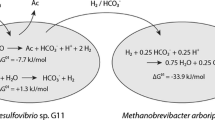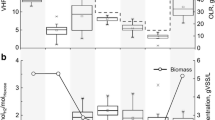Abstract
The effect of different electron acceptors on substrate degradation was studied in pure and mixed cultures of various hydrogenotrophic homoacetogenic, methanogenic, sulfate-reducing, fumarate-reducing and nitrate-ammonifying bacteria. Two different species of these bacteria which during organic substrate degradation produce and consume hydrogen, were cocultured on a substrate which was utilized only by one of them. Hydrogen, which was excreted as intermediate by the first strain (and reoxidized in pure culture), could, depending on the hydrogen acceptor present, also be used by the second organism, resulting in interspecies hydrogen transfer. The efficiency of H2 transfer was similar when methanol, lactate or fructose were used as organic substrate, although the free energy changes of fermentative H2 formation of these substrates are considerably different. In coculture experiments nitrate or fumarate>sulfate> CO2/CH4>sulfur or CO2/acetate were the preferred electron acceptors, and an increasing percentage of H2 was transferred to that bacterium which was able to utilize the preferred electron acceptor. In pure culture the threshold values for hydrogen oxidation decreased in the same order from ≤1,100 ppm for homoacetogenic bacteria to about 0.03 ppm for nitrate or fumarate reducing bacteria. The determined H2-threshold values as well as the percentage of H2 transfer in cocultures were related to the Gibbs free energy change of the respective hydrogen oxidizing reaction.
Similar content being viewed by others
References
Abram JW, Nedwell DB (1978a) Inhibition of methanogenesis by sulfate reducing bacteria competing for transferred hydrogen. Arch Microbiol 117:89–92
Abram JW, Nedwell DB (1978b) Hydrogen as a substrate for methanogenesis and sulfate reduction in anaerobic saltmarsh sediment Arch Microbiol 117:93–97
Archer DB, Powell GE (1985) Dependence of the specific growth rate of methanogenic mutualistic cocultures on the methanogen. Arch Microbiol 141:133–137
Bache R, Pfennig N (1981) Selective isolation Acetobacterium woodi on methoxylated aromatic acids and determination of growth yields. Arch Microbiol 130:255–261
Bokranz M, Katz J, Schröder J, Roberton AM, Kröger A (1983) Energy metabolism and biosynthesis of Vibrio succinogenes growing with nitrate or nitrite as terminal electron acceptors. Arch Microbiol 135:36–40
Boone DR, Bryant MP (1980) Propionate-degrading bacterium, Syntrophobacter wolinii sp. nov. gen. nov., from methanogenic ecosystems. Appl Environ Microbiol 40:626–632
Boone DR, Menaia JAGF, Mah RA (1987) Effects of hydrogen pressure during growth and effects of pregrowth with hydrogen on acetate degradation by Methanosarcina species. Appl Environ Microbiol 53:83–87
Bryant MP, (1979) Microbial methane production-theoretical aspects. J Anim Sci 48:193–201
Conrad R, Phelps TJ, Zeikus JG (1985) Gas metabolism evidence in support of the juxtaposition of hydrogen-producing and methanogenic bacteria in sewage sludge and lake sediments. Appl Environ Microbiol 50:595–601
Conrad R, Schink B, Phelps TJ (1986) Thermodynamics of H2-consuming and H2-producing metabolic reactions in diverse methanogenic environments under in situ conditions. FEMS Microbiol Ecol 38:353–360
Cord-Ruwisch R (1985) A quick method for the determination of dissolved and precipitated sulfides in cultures of sulfate-reducing bacteria. J Microbiol Meth 4:33–36
Cord-Ruwisch R (1986) Facultative and partial interspecies hydrogen transfer-competition for reducing equivalents. In: Dubourguier HC, Albagnac G, Montreuil J, Romond C, Sautiere P, Guillaume J (eds) Biology of anaerobic bacteria. Elsevier, Amsterdam pp 16–22
Cord-Ruwisch R, Ollivier B (1986) Interspecific hydrogen transfer during methanol degradation between Sporomusa acidovorans and hydrogenophilic anaerobes. Arch Microbiol 144:163–165
Cord-Ruwisch R, Ollivier B, Garcia J-L (1986) Fructose degradation by Desulfovibrio sp. in pure culture and in coculture with Methanospirillum hungatei. Curr Microbiol 13:285–289
Gribić-Galić D (1985) Fermentative and oxidative transformation of ferulate by fermentatively anaerobic bacteria isolated from sewage sludge. Appl Environ Microbiol 50:1052–1057
Hatchikian EC, Chaigneau M, LeGall J (1976) Analysis of gas production by growing cultures of three species of sulfate-reducing bacteria. In: Schlegel HG, Gottschalk G, Pfennig N (eds) Microbial production and utilization of gases. Goltze, Göttingen, pp 109–118
Heijthuijsen JHFG, Hansen TA (1986) Interspecies hydrogen transfer in co-cultures of methanol utilizing acidogens and sulfate-reducing or methanogenic bacteria. FEMS Microbiol Ecol 38:57–62
Hukelikian H (1943) Effects of the addition of sodium nitrate on sewage hydrogen sulfide production and BOD Reduction. Sewage Works J 15:255–259
Hungate RE (1967) Hydrogen as an intermediate in the rumen fermentation. Arch Mikrobiol 59:158–164
Jenneman GE, McInerney, Knapp, RM (1986) Effect of nitrate on biogenic sulfide production. Appl Environ Microbiol 51: 1205–1211
Kristiansson JK, Schönheit P, Thauer RK (1982) Different K s values for hydrogen of methanogenic bacteria and sulfate reducing bacteria: an explanation for the apparent inhibition of methanogenesis by sulfate. Arch Microbiol 131:278–282
Krzycki JA, Morgan JB, Conrad R, Zeikus JG (1987) Hydrogen metabolism during methanogenesis from acetate by Methanosarcina barkeri. FEMS Microbiol Lett 40:1193–1198
Lovley DR (1985) Minimum threshold for hydrogen metabolism in methanogenic bacteria. Appl Environ Microbiol 49:1530–1531
Lovley DR, Ferry JG (1984) Production and consumption of H2 during growth of Methanosarcina spp. on acetate. Appl Environ Microbiol 49:247–249
Lovley DR, Klug MJ (1983) Sulfate reducers can outcompete methanogens at freshwater sulfate concentrations. Appl Environ Microbiol 45:187–192
Lovley DR, Dwyer DF, Klug MJ (1982) Kinetic analysis of competition between sulfate reducers and methanogens for hydrogen in sediments. Appl Environ Microbiol 43:1373–1379
Lupton FS, Zeikus JG (1984) Physiological basis for sulfate-dependent hydrogen competition between sulfidogens and methanogens. Curr Microbiol 11:7–12
Lupton FS, Conrad R, Zeikus JG (1984) Physiological function of hydrogen metabolism during growth of sulfidogenic substrates. J Bacteriol 1959:843–849
Mah RA (1982) Methanogenesis and methanogenic partnerships. Phil Trans R Soc Lond B 297:599–616
McInerney MJ, Bryant MP (1980) Review of methane fermentation fundamentals. In: Wise DL (ed) Fuel gas production from biomass. Chemical Rubber Co. Press, West Palm Beach, pp 20–46
McInerney MJ, Bryant MP, Hespell RB, Costerton JW (1981) Synthrophomonas wolfei gen. nov. sp. nov., an anaerobic synthrophic, fatty acid oxidizing bacterium. Appl Environ Microbiol 41:1029–1039
Mountfort DO, Bryant MP (1982) Isolation and characterization of an anaerobic syntrophic benzoate degrading bacterium from sewage sludge. Arch Microbiol 133:249–256
Novelli PC, Scranton MI, Michener RH (1987) Hydrogen distributions in marine sediments. Limnol Oceanogr 32:565–576
O'Brien JM, Wolkin RH, Moench TT, Morgan JB, Zeikus JG (1984) Association of hydrogen metabolism with unitrophic or mixotrophic growth of Methanosarcina barkeri on carbon monoxide. J Bacteriol 158:373–375
Phelps TJ, Conrad R, Zeikus JG (1985) Sulfate-dependent interspecies H2 transfer between Methanosarcina barkeri and Desulfovibrio vulgaris during coculture metabolism of acetate or methanol. Appl Environ Microbiol 50:589–594
Powell GE (1984) Equalisation of specific growth rates for syntrophic associations in batch culture. J Chem Tech Biotechnol 34B:97–100
Powell GE (1985) Stable coexistence of syntrophic associations in continuous culture. J Chem Tech Biotechnol 35B:46–50
Robinson JA, Tiedje JM (1984) Competition between sulfate-reducing and methanogenic bacteria for H2 under resting and growing conditions. Arch Microbiol 137:26–32
Robinson JA, Strayer RF, Tiedje JM (1981) Method for measuring dissolved hydrogen in anaerobic ecosystems: applications to the rumen. Appl Environ Microbiol 41:545–548
Schink B (1987) Principles and limits of anaerobic degradation: environmental and technological aspects. In: Zehnder AJB (ed) Environmental microbiology of anaerobes. Wiley, New York, in press
Seiler W (1978) The influence of the biosphere on the atmospheric CO and H2 cycles. In: Krumbein WE (ed) Environmental biogeochemistry and geomicrobiology, vol 3. Ann Arbor Science Publ Ann Arbor, MI, pp 773–810
Seiler W, Giehl H, Roggendorf P (1980) Detection of carbon monoxide and hydrogen by conversion of mercury oxide to mercury vapor. Atmos Technol 12:40–45
Seitz H-J, Cypionka H (1986) Chemolithotrophic growth of Desulfovibrio desulfuricans with hydrogen coupled to ammonification of nitrate. Arch Microbiol 146:63–67
Strayer RF, Tiedje JM (1978) Kinetic parameters of the conversion of methane precursors to methane in hypereutrophic lake sediment. Appl Environ Microbiol 36:330–340
Thauer RK, Jungermann K, Decker K (1977) Energy conservation in chemotrophic anaerobic bacteria. Bacteriol Rev 41:100–180
Traoré SA, Hatchikian EC, Belaich JP, LeGall J (1981) Microcalorimetric studies of the growth of sulfate-reducing bacteria. Energetics of D. vulgaris growth. J Bacteriol 45:191–199
Tschech A, Pfennig N (1984) Growth yield increase linked to caffeate reduction in Acetobacterium woodii. Arch Microbiol 137:163–167
Tsuji K, Yagi T (1980) Significance of hydrogen burst from growing cultures of Desulfovibrio vulgaris, Miyazaki and the role of hydrogenase and cytochrome c3 in energy producing system. Arch Microbiol 125:35–42
Tzeng SF, Bryant MP, Wolfe RS (1975) Factor 420-dependent pyridine nucleotide-linked formate metabolism of Methanobacterium ruminantium. J Bacteriol 121:192–196
Ward DM, Winfrey MR (1986) Interactions between methanogenic and sulfate-reducing bacteria in sediments. Adv Aquat Microbiol 3:141–179
Widdel F, Pfennig N (1984) Dissimilatory sulfate- or sulfur-reducing bacteria. In: Krieg NR, Holt JG (eds) Bergey's manual of systematic bacteriology. Williams & Wilkins, Baltimore London, pp 663–679
Winfrey MR, Zeikus JG (1977) Effect of sulfate on carbon and electron flow during microbial methanogenesis in freshwater sediments. Appl Environ Microbiol 33:275–281
Wolin MJ (1982) Hydrogen transfer in microbial communities. In: Bull AT, Slater JH (eds) Microbial interactions and communicaties. Academic Press, London, pp 475–543
Zehnder AJB (1978) Ecology of methane formation. Water pollution Microbiol 2:349–376
Author information
Authors and Affiliations
Additional information
Parts of this work (grant to R C-R) was supported by the European Community (ST2A-0022)
Rights and permissions
About this article
Cite this article
Cord-Ruwisch, R., Seitz, HJ. & Conrad, R. The capacity of hydrogenotrophic anaerobic bacteria to compete for traces of hydrogen depends on the redox potential of the terminal electron acceptor. Arch Microbiol 149, 350–357 (1988). https://doi.org/10.1007/BF00411655
Received:
Accepted:
Issue Date:
DOI: https://doi.org/10.1007/BF00411655




